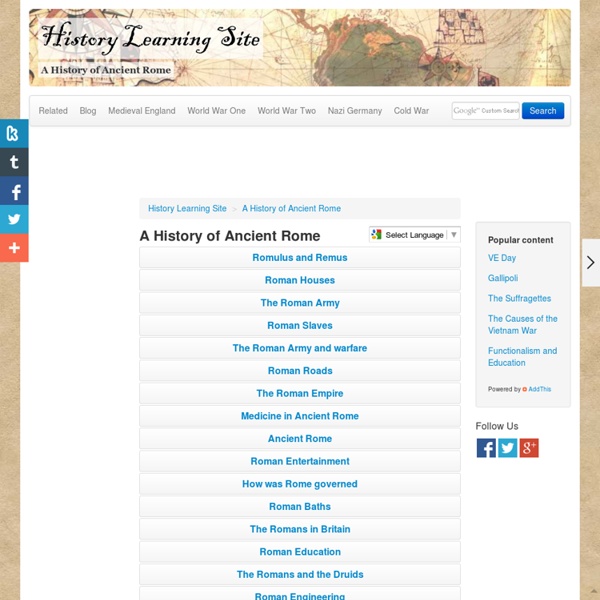



http://www.historylearningsite.co.uk/a_history_of_ancient_rome.htm
Related: Cultura classica - Classics • Ancient RomeClassical Reception Studies Network The Classical Reception Studies Network (CRSN) aims to facilitate the exchange of information and to encourage collaboration in the field of classical reception studies by bringing together departments and individuals from across the world. Classical Reception Studies is the inquiry into how and why the texts, images and material cultures of Ancient Greece and Rome have been received, adapted, refigured, used and abused in later times and often other places. For more information on the Network and its history, please go to the Network page which explains who we are and what we do. The Events section lists current and future Classical Reception conferences, seminars, workshops and performances. "Happy Birthday, everyone - and many happy returns!"
The Extent of the Roman Empire Time has seen the rise and fall of a number of great empires - the Babylonian, the Assyrian, the Egyptian, and lastly, the Persian. Regardless of the size or skill of their army or the capabilities of their leaders, all of these empires fell into ruin. History has demonstrated that one of the many reasons for this ultimate decline was the empire’s vast size - they simply grew too large to manage, falling susceptible to external, as well as internal, forces. One of the greatest of these empires was, of course, the Roman Empire. Over the centuries it grew from a small Italian city to control land throughout Europe across the Balkans to the Middle East and into North Africa. Population & Spread Secrets of Lost Empires by Dennis Gaffney Aqueducts are one of the wonders of the Roman Empire. These graceful structures are not only majestic, but are engineering marvels that survive to this day. In "Construct an Aqueduct," you are hired as Chief Water Engineer by the Roman Emperor. Your job: to build an aqueduct that will supply the Roman city of Aqueductis with clean water to private homes, public baths and glorious fountains.
Warburg Institute digital copy antiquities Catalogue Articles You are not logged in | My saved items (0 items) | Login Give Feedback How 3rd century Chinese saw the Romans A country of “numerous minor kings” where fierce tigers and lions kill travelers. That doesn’t sound like your average description of Rome, does it? The borders of the Roman Empire and Han China around 100 AD. It’s hard to forget just how connected the world is nowadays. In ancient times, most people would be blissfully unaware of the entire world outside their local community. The average Chinese, for instance, would have never known that elsewhere on the globe, a glorious people called the Romans ruled over a massive empire.
A History of Surgery By Tim Lambert Ancient Surgery In the stone age some adults had holes cut in their skulls. At least sometimes people survived the 'operation' because the bone grew back. We do not know the purpose of the 'operation'. LacusCurtius — Smith's Dictionary of Greek and Roman Antiquities LacusCurtius Educational Resource: a Selection of Articles from A 19th-Century Classical Encyclopaedia William Smith, D.C.L., LL.D.: A Dictionary of Greek and Roman Antiquities John Murray, London, 1875. This single volume, of 1294 pages in rather fine print set in two columns and amounting to well over a million words, is a treasure trove of information on the ancient world, and was for many years a standard reference work, carried thru several British and American editions from the first in 1842 to the last in 1890‑91 with relatively few alterations.
The Roman Domus The Roman domus was much more than a place of dwelling for a Roman familia. It also served as a place of business and a religious center for worship. The size of a domus could range from a very small house to a luxurious mansion. In some cases, one domus took up an entire city-block, while more commonly, there were up to 8 domus per insula (city-block). All domus were free-standing structures. Some were constructed like modern-day townhouses with common walls between them, while others were detached.
A Brief History of Medicine During the 18th century medicine made slow progress. Doctors still did not know what caused disease. Some continued to believe in the four humors (although this theory declined during the 18th century). Other doctors thought disease was caused by 'miasmas' (odorless gases in the air). However surgery did make some progress. Home - Classics - LibGuides at Credo Reference Credo LibGuides can be linked to from your institution's webpage. For LibGuides subscribers, these guides may be freely copied and modified to create or supplement your own LibGuides. Learn how to copy a LibGuide. When clicking on the links, your Credo account is accessed by IP authentication or through your institution's proxy server. For help with access issues, contact libguides@credoreference.com
Why Roman concrete still stands strong while modern version decays Their structures are still standing more than 1,500 years after the last centurion snuffed it: now the Romans’ secret of durable marine concrete has finally been cracked. The Roman recipe – a mix of volcanic ash, lime (calcium oxide), seawater and lumps of volcanic rock – held together piers, breakwaters and harbours. Moreover, in contrast to modern materials, the ancient water-based structures became stronger over time. Scientists say this is the result of seawater reacting with the volcanic material in the cement and creating new minerals that reinforced the concrete. “They spent a tremendous amount of work [on developing] this – they were very, very intelligent people,” said Marie Jackson, a geologist at the University of Utah and co-author of a study into Roman structures.